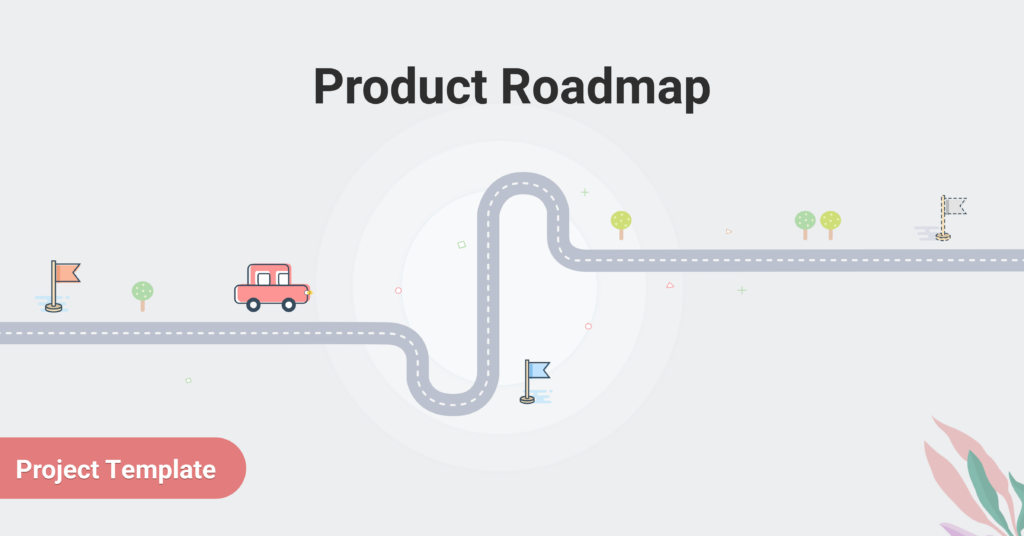“A roadmap is essential for any journey, as it helps you navigate your way to your destination, and stay on track even when obstacles arise.” – Simon Sinek
A Product Roadmap is a high-level visual representation of a product’s strategy, plan, and goals. It is essential for product managers, stakeholders, and teams to align their efforts toward product growth. It helps prioritize steps toward the implementation of the product’s planned features, releases, and initiatives.
A product roadmap template is a pre-designed framework that you can use as a starting point to create your own. In this post, we’ll introduce you to Avaza’s product roadmap template and give some ideas and inspiration on how to put together your own.
Many companies use still Excel or Powerpoint for putting together the roadmap. However, these are inefficient to update and have limitations as the product grows and evolves. Using the right project management software for the roadmap allows you many flexible options to customize, adapt and easily update information, and collaborate more effectively with stakeholders.
The main elements of a product roadmap often include:
Objectives: What are the main goals for the product?
Features: What features will be delivered and when?
Deliverables: What are the main deliverables for the product?
Timeline: When should each objective, feature, and deliverable be achieved?
Project layouts will differ according to the nature of the product, but following are some high-level rules and benefits to keep in mind when putting together a product roadmap for your company:
Collaborative: A product roadmap template should help to facilitate collaboration among stakeholders and teams. It should make it easier to get everyone on the same page and to keep everyone informed.
Descriptive: A product roadmap helps breaks down complex concepts into understandable and implementable chunks. A good software will allow you to use Kanban boards (they come with handy drag and drop functionality) and Gantt charts (visually intuitive) as well as a regular List view. The roadmap should make use of colourful tags, categories and statuses for visual appeal as well as clarity.
Modifiable: It is easier to make changes that apply across the board when using a product roadmap software. Such tools are flexible and adaptable, hence the roadmap is able to be modified as per changing requirements and input. You should be able to add, modify, or remove elements to make the roadmap work best for your product and team.
Trust-building with customers: Publicly available product roadmaps are shareable on the company website and other communication channels accessible to customers. They are a great way of letting customers know what is the intended product direction and spur them on for giving input on the same.
Consultative: Product roadmaps are meant to help keep everyone on the same page and reduce the risk of misunderstandings. Hence the process of putting together and updating the roadmap should avoid a top-down approach, and involve structured input from team members, existing and intended customer base, external stakeholders etc. Sales and Customer service teams have high-touch engagement with your end-users, know what they are looking for, and what feature requests typically come up. Conducting surveys and feedback sessions will help product managers prioritize future product releases. Direct feedback from existing customers, as well as potential customers can further help refine your product strategy. Finally, product users can rely on their overall company vision and mission to identify the strategic goals they will achieve with the help of the product feature releases.
Simplicity: Product roadmaps should help to simplify complex information and make it easier for stakeholders to grasp the product’s strategy, goals, and plans. Hence a balance between too much detail and too little should be struck. You need not spell out the nitty gritty details, mention non-productive routine activities like product maintenance, bug-fixes etc. or even give exact release dates. At the same time, the entries should be self-explanatory and descriptive enough to be universally understood and depict the strategic dirction of the product team.
Avaza Product Roadmap Template
To get you inspired we started off with Avaza, we have put together a series of templates (Avaza Public Projects) that you can use as free guides to create your own projects customized for your needs.
You can see the Avaza Product Roadmap public project below. The project separates product features into Recently Completed, Planned, and Considering sections. Our Kanban view makes it possible for you to add a display image on each product feature (called Tasks in Avaza) to make your project visually appealing and descriptive. Clicking on a Task will reveal a brief description, and any relevant links and attachments.
We also use Task Tags to depict which module the feature classifies under and Task Status to describe the specific stage the feature is in (E.g Research, Design, Development, Testing, etc.). Progress Bar will reveal the percentage of completion for the Planned and Considering Tasks. The Completed Tasks showcase their date of completion.
We would love our wonderful community of customers to share their projects with the world as well, to help guide and inspire others toward project management success! Find out here how to create your first Public Project (Note: you will have the flexibility to pick and choose which aspect of your internal projects to keep confidential and which to display)


2 Comments
Yay More Templates!
We have started adding project templates here https://www.avaza.com/blog/project-templates/
We plan to add new project templates soon.